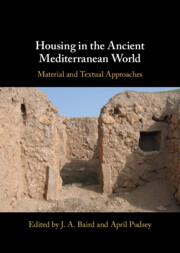Book contents
- Housing in the Ancient Mediterranean World
- Housing in the Ancient Mediterranean World
- Copyright page
- Contents
- Figures
- Tables
- Contributors
- Acknowledgements
- Introduction
- 1 Kinship ‘In the Halls’
- 2 Domesticating the Ancient House
- 3 Mind the Gap
- 4 A Family Affair
- 5 Textiles in Alkestis’ thalamos
- 6 Architectural Rhetoric and the Rhetoric of Architecture
- 7 The Reconstruction of an Agricultural Landscape
- 8 Mudbricks and Papyri from the Desert Sand
- 9 Housing and Community
- 10 The Elusive vestibulum
- 11 Living in the Liminal
- 12 Experiencing Sense, Place and Space in the Roman Villa
- 13 Houses and Time
- 14 Spaces of Desire
- 15 A Response: ‘Using the Material and Written Sources’ Revisited
- Index
- References
11 - Living in the Liminal
Lares Compitales Shrines, Freedmen and Identity in Delos
Published online by Cambridge University Press: 08 July 2022
- Housing in the Ancient Mediterranean World
- Housing in the Ancient Mediterranean World
- Copyright page
- Contents
- Figures
- Tables
- Contributors
- Acknowledgements
- Introduction
- 1 Kinship ‘In the Halls’
- 2 Domesticating the Ancient House
- 3 Mind the Gap
- 4 A Family Affair
- 5 Textiles in Alkestis’ thalamos
- 6 Architectural Rhetoric and the Rhetoric of Architecture
- 7 The Reconstruction of an Agricultural Landscape
- 8 Mudbricks and Papyri from the Desert Sand
- 9 Housing and Community
- 10 The Elusive vestibulum
- 11 Living in the Liminal
- 12 Experiencing Sense, Place and Space in the Roman Villa
- 13 Houses and Time
- 14 Spaces of Desire
- 15 A Response: ‘Using the Material and Written Sources’ Revisited
- Index
- References
Summary
In addition to being the primary locus of family interaction and daily activity, the house is a mediating space where individual lifestyles, social order and cultural conventions meet. This chapter investigates the domestic ritual material remains related to the Italian Lares compitales cult on Delos, in the 2nd and 1st centuries BCE, focusing on the shrines’ relationship with the expression and negotiation of different forms of group identities, and drawing on archaeological and textual evidence. Lares compitales shrines represent the material remains of the repeated social practice related to the expression of membership within this public cult, which in turn functioned as a means of group identity (or community) creation for freedmen, a newly formed civic group increasing in number during this period. Locating domestic space and associated activities within a liminal zone existing within, and/or confounding, the realms of public and private, this contribution contends that these shrines not only provided a physical location for certain activities related to this cult, but also performed a social function as a means of communicating and negotiating identities through the material expression of repeated social practice.
- Type
- Chapter
- Information
- Housing in the Ancient Mediterranean WorldMaterial and Textual Approaches, pp. 354 - 380Publisher: Cambridge University PressPrint publication year: 2022



